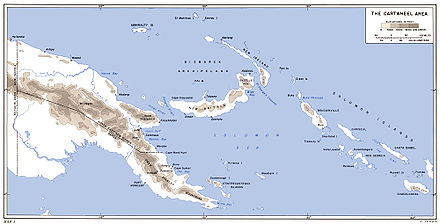Operation Cartwheel
1942
Rabaul -
1. Salamaua-Lae -
Operation MO -
Coral Sea -
1. Buna-Gona -
Kokoda Track -
Milne Bay -
Goodenough -
2. Buna-Gona -
Operation Lilliput
1943
Wau -
Bismarck Sea -
I -
2. Salamaua – Lae -
Finisterre -
Cartwheel -
Bougainville -
Huon -
Dexterity / Arawe -
Bombing of Rabaul
1944 - 1945
Admiralty Islands -
Emirau -
Take Ichi convoy -
Reckless -
Persecution -
Wakde-Sarmi -
Biak -
Noemfoor -
Driniumor -
Sansapor -
Morotai -
Aitape – Wewak
Operation Cartwheel (German Operation Wagenrad ) was an allied company in the Pacific War during World War II . It was launched on June 30, 1943 and lasted until 1944. It aimed at the isolation of the important Japanese base Rabaul in New Britain .
prehistory
In February 1942, the Japanese took Rabaul, which was occupied by Australian units and belonged to the territory of New Guinea . They built a large fortified supply base here for their advance in the South Pacific, which was considered a major obstacle for the Allies.
preparation
The Allied Commander in Chief in the Southwest Pacific Area (SWPA), General Douglas MacArthur was responsible for planning and execution . Directly involved in the operation were troops from the United States and Australia . Even New Zealand units and US troops, the commander of the Pacific Ocean Areas (POA) Admiral Chester W. Nimitz were under were indirectly involved as they continue east through the Solomon Islands on Bougainville were advancing.
A few days after the Guadalcanal operations were completed in early February 1943, MacArthur submitted his revised operational plan. In it he also requested five American army divisions to launch a direct attack on Rabaul. Furthermore, Australian forces should be made available to him. On March 28, 1943, the Joint Chiefs of Staff MacArthur issued a directive for the isolation of Rabaul, which included three forays into Bougainville (Solomon Islands), eastern New Guinea and western New Britain. In addition, he received support from the newly established 6th US Army under the command of Lieutenant General Walter Krueger , which also became known under its code name Alamo Force .
The commands of the directive were as follows:
- Construction of airfields on Kiriwina and Woodlark Island , off the eastern tip of New Guinea.
- The conquest of Lae and Salamaua on Huongolf , Finschhafen on the Huon Peninsula and Madang on the north coast of New Guinea
- The landing at Cape Gloucester on the western tip of New Britain ( Operation Dexterity )
- The capture of the northern Solomon Islands including New Georgia to the southern half of Bougainville
Even before the operation began, the Commander in Chief of the Combined Fleet, Admiral Yamamoto Isoroku, was shot down by American fighter planes on the flight from Rabaul to Bougainville on April 18 ( Operation Vengeance ); his successor was Koga Mineichi .
course
On June 30, the Allies launched simultaneous attacks in New Guinea and New Georgia in the Solomon Islands. Woodlark and Kiriwina were occupied without resistance on the same day. The Battle of New Georgia , led by Admiral William Halsey on the Allied side , did not go smoothly, as the attackers were faced with a large Japanese garrison and the terrain was very difficult. It lasted until August, delaying the attack on Bougainville until November.
The main responsibility for the operations in the eastern part of New Guinea rests with the Australian General Thomas Blamey . The attack on Lae and Salamaua from the land side was supported by a combined air and sea landing at Lae in early September and Lae was captured on September 15. The Australian New Guinea Army then marched along the Finisterre Mountains towards Madang, which fell in April 1944. The landing forces carried out another landing at Finschhafen on September 22nd, which they captured in January 1944 (see Battle of the Huon Peninsula ).
The landing on New Britain - Operation Dexterity - was carried out by the 6th US Army. The landings took place on December 15 at Arawe on the south coast and on December 26 at Cape Gloucester . The land forces received support from the Allied Air Forces, led by Lieutenant General George Kenney , and the naval forces under Vice Admiral Arthur S. Carpender . By February 1944, the Japanese withdrew from the western part of the island.
Result
The operation, which lasted until 1944, demonstrated the effectiveness of a strategy that bypasses the highly concentrated enemy units with the aim of destroying the enemy’s lines of communication and supply. Rabaul himself could be held by the Japanese until the end of the war.
The simultaneous actions against the Gilbert and Marshall Islands in early 1944 made the main Japanese naval base in the South Pacific Truk untenable. The strategic focus of the war shifted to the Central Pacific in 1944 - first to the Mariana Islands , then with the conclusion of the main operations in New Guinea to the Philippines.
See also
literature
- John Miller Jr. (1959). CARTWHEEL: The Reduction of Rabaul . United States Army in World War II: The War in the Pacific 418. Office of the Chief of Military History, US Department of the Army.



